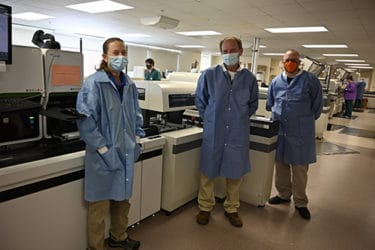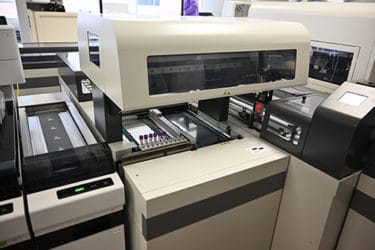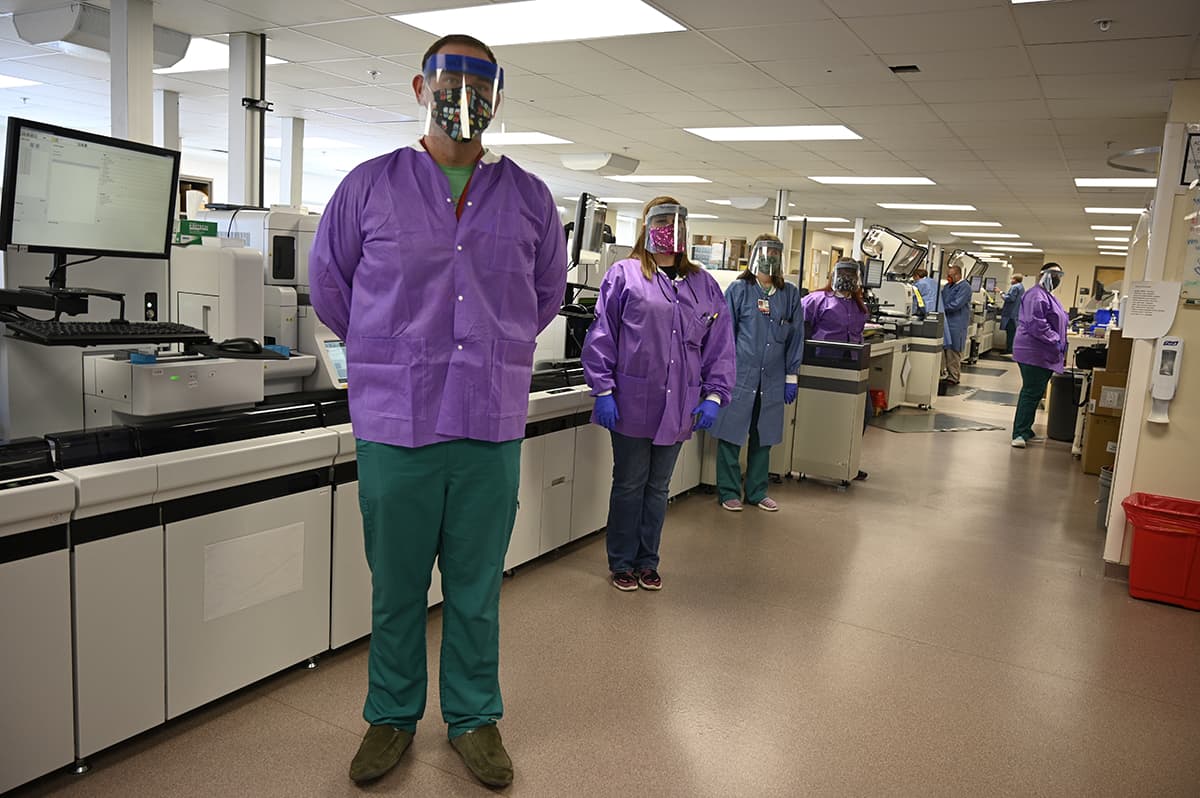First-in-the-Nation Technology Saves Lab Labor, Testing Time
| A first-in-the-nation innovative piece of technology installed between two automated lines in a large UAMS lab has shaved turnaround time for test results by 10-15 minutes and allows skilled technologists more time for complex analysis.
The new automated arm joins the chemistry line made by Beckman Coulter to the hematology testing line made by Sysmex, two companies that have been competitors.

Three of the Beckman Coulter personnel who worked on-site at UAMS stand in front of the new unit they put in that joins the Beckman Coulter and Sysmex automated lines.
Before the installation was finished in early July, technologists working in the service line had to take racks of blood samples in test tubes from one hematology machine to the next, often interrupting more complicated lab work they were doing.
“It is labor and steps when you think about how hard it is on employees to walk back and forth physically for hours every day,” said Susan Lesourd, automation manager of the UAMS Clinical Lab. “It’s not unusual for us to clock 10,000 steps on one shift. The new unit line will take out that routine process you have to do – centrifuging, receiving the tubes, carrying them to the instruments, loading them on, taking them off, storing them at the right temperature. It’s a big deal.”
Lesourd said the automated testing lines run continuously around the clock all year, performing as many as 6 million tests annually.
The improvements eliminate about five minutes from the length of time tests results take to come back, in some cases as much as 10-15 minutes. Previously, the workflow only allowed for full racks of samples to be sent through. Now, they can process smaller batches when needed.
The upgrades also will save the equivalent of several full-time employees, technologists who can be redeployed to other areas or simply be able to focus more exclusively on other work.
“Being hands off on our hematology line now allows our technicians to stop doing menial tasks and support more troubleshooting and critical thinking corresponding to their training,” said Ericka Olgaard, D.O., medical director of the UAMS Laboratory and Pathology Service Line. “The goal was to reduce the non-value added labor and allow them to create value.”

This is the new unit that joins the automated lines and annually will save thousands of hours of labor in the UAMS Clinical Lab.
The effort to upgrade the automation line began more than two years ago when Olgaard, Lesourd and Kim Sanderson, senior manager of UAMS Clinical Laboratories, along with dozens of other technologists began brainstorming about what they wanted to see happen when UAMS replaced the existing 12-year-old automated testing line. That involved site visits to research how other newer lines were operating.
When it came time to contract with the companies selected, UAMS asked for innovative technology that would enable work done with samples on the Beckman Coulter machine to be conveyed to the Sysmex part of the line. UAMS leases the instruments under the contract, and the lease cost is calculated per test. Beckman built the arm component in close consultation with Sysmex. Once testing was done in Chicago and the federal Food and Drug Administration approved its use, plans for installation began.
“It took a little bit of motivational pushing from us, but the companies worked well together,” Sanderson said.
The new Beckman Coulter chemistry line and the Sysmex lines were installed about a year ago, so everyone working in the service line has been anticipating having the last piece in place.
“We’re all really excited,” Sanderson said. “It’s been a long time coming. I appreciate the companies actually taking the time to work together.”
The companies didn’t just make improvements to hardware. They also made other adjustments along the lines to software and other processing segments, enabling the better tracking of samples when further testing is need, Lesourd said. Finding a sample for add on testing just became more efficient, too.
The ultimate goal is a touchless system from the start of the chemistry line to the end of the hematology line. That also means a reduced risk to UAMS technologists.
“A major benefit of automation and the new robotics is safety,” Lesourd said. “Automation helps protect technologists from biohazardous aerosols, spills and splashes. It also increases patient safety by helping by automating labeling, sample integrity analysis and specimen tracking.”
Medical testing laboratories across the United States are waiting to see how the new cutting-edge technology in UAMS’ automated clinical testing line delivers new efficiencies and shortens the time it takes for results.
“This is a technology gap in many labs and automated testing lines,” Olgaard said.
Peer institutions face similar challenges, and UAMS is pioneering a solution with a positive impact well beyond the university’s campus and Arkansas.
